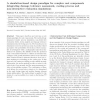Free Online Productivity Tools
i2Speak
i2Symbol
i2OCR
iTex2Img
iWeb2Print
iWeb2Shot
i2Type
iPdf2Split
iPdf2Merge
i2Bopomofo
i2Arabic
i2Style
i2Image
i2PDF
iLatex2Rtf
Sci2ools
EWC
2007
2007
A simulation-based design paradigm for complex cast components
This paper describes and exercises a new design paradigm for cast components. The methodology integrates foundry process simulation, non-destructive evaluation (nde), stress analysis and damage tolerance simulations into the design process. The foundry process simulation is used to predict an array of porosity related anomalies. The probability of detection of these anomalies is investigated with a radiographic inspection simulation tool (xrsim). The likelihood that the predicted array of anomalies will lead to a failure is determined by a fatigue crack growth simulation based on the extended finite element method, xfem and therefore does not require meshing nor remeshing as the cracks grow. In this approach, the casting modelling provides initial anomaly information, the stress analysis provides a value for the critical size of an anomaly and the nde assessment provides a detectability measure. The combination of these tools allows for accept/reject criteria to be determined at the e...
| Added | 14 Dec 2010 |
| Updated | 14 Dec 2010 |
| Type | Journal |
| Year | 2007 |
| Where | EWC |
| Authors | Stéphane P. A. Bordas, James G. Conley, Brian Moran, Joe Gray, Ed Nichols |
Comments (0)

